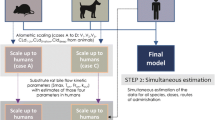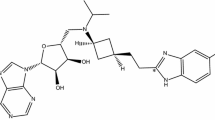Abstract
Rolofylline is a potent, selective adenosine A1 receptor antagonist that was under development for the treatment of patients with acute congestive heart failure and renal impairment. Rolofylline is metabolized primarily to the pharmacologically active M1-trans and M1-cis metabolites (metabolites) by cytochrome P450 (CYP) 3A4. The aim of this investigation was to provide a pharmacokinetic (PK) model for rolofylline and metabolites following intravenous administration to healthy volunteers. Data included for this investigation came from a randomized, double-blind, dose-escalation trial in four groups of healthy volunteers (N = 36) where single doses of rolofylline, spanning 1 to 60 mg ,were infused over 1–2 h. The rolofylline and metabolite data were analyzed simultaneously using NONMEM. The simultaneous PK model comprised, in part, a two-compartment linear PK model for rolofylline, with estimates of clearance and volume of distribution at steady-state of 24.4 L/h and 239 L, respectively. In addition, the final PK model contained provisions for both conversion of rolofylline to metabolites and stereochemical conversion of M1-trans to M1-cis. Accordingly, the final model captured known aspects of rolofylline metabolism and was capable of simultaneously describing the PK of rolofylline and metabolites in healthy volunteers.




Similar content being viewed by others
References
Slawsky MT, Givertz MM. Rolofylline: a selective adenosine 1 receptor antagonist for the treatment of heart failure. Expert Opin Pharmacother. 2009;10(2):311–22.
Briggs JP, Schnermann J. The tubuloglomerular feedback mechanism—functional and biochemical aspects. Annu Rev Physiol. 1987;49:251–73.
Welch WJ. Adenosine A(1) receptor antagonists in the kidney: effects in fluid-retaining disorders. Curr Opin Pharmacol. 2002;2:165–70.
Cotter G, Dittrich HC, Weatherley BD, Bloomfield DM, O’Connor CM, Metra M, et al. The PROTECT pilot study: a randomized, placebo-controlled, dose-finding study of the adenosine A(1) receptor antagonist rolofylline in patients with acute heart failure and renal impairment. J Card Fail. 2008;14:631–40.
Dittrich HC, Gupta DK, Hack TC, Dowling T, Callahan J, Thomson S. The effect of KW-3902, an adenosine A(1) receptor antagonist, on renal function and renal plasma flow in ambulatory patients with heart failure and renal impairment. J Card Fail. 2007;13:609–17.
Givertz MM, Massie BM, Fields TK, Pearson LL, Dittrich HC. The effects of KW-3902, an adenosine A1-receptor antagonist, on diuresis and renal function in patients with acute decompensated heart failure and renal impairment or diuretic resistance. J Am Coll Cardiol. 2007;50:1551–60.
Weatherley BD, Cotter G, Dittrich HC, Delucca P, Mansoor GA, Bloomfield DM, et al. Design and rationale of the PROTECT study: a placebo-controlled randomized study of the selective A1 adenosine receptor antagonist rolofylline for patients hospitalized with acute decompensated heart failure and volume overload to assess treatment effect on congestion and renal function. J Card Fail. 2010;16:25–35.
Stroh M, Dishy V, Radziszewski W, Hwang E, Lazarus-Shipitofsky N, Dittrich H, et al. The effects of multiple doses of rolofylline on the single-dose pharmacokinetics of midazolam in healthy subjects. Am J Ther. 2010;17:53–60.
Radziszewski W, Lai E, Shipitofsky NL, Stroh M, Dishy V, Han LL, et al. A single supratherapeutic dose of rolofylline does not prolong the QTcF interval in healthy volunteers. Am J Ther. 2010;17:8–16.
Duffull SB, Chabaud S, Nony P, Laveille C, Girard P, Aarons L. A pharmacokinetic simulation model for ivabradine in healthy volunteers. Eur J Pharm Sci. 2000;10:285–94.
Klein CE, Gupta E, Reid JM, Atherton PJ, Sloan JA, Pitot HC, et al. Population pharmacokinetic model for irinotecan and two of its metabolites, SN-38 and SN-38 glucuronide. Clin Pharmacol Ther. 2002;72:638–47.
Chis OT, Banga JR, Balsa-Canto E. Structural identifiability of systems biology models: a critical comparison of methods. PLoS One. 2011;6:e27755.
Yates JW, Jones RD, Walker M, Cheung SY. Structural identifiability and indistinguishability of compartmental models. Expert Opin Drug Metab Toxicol. 2009;5:295–302.
Bellu G, Saccomani MP, Audoly S, D’Angio L. DAISY: a new software tool to test global identifiability of biological and physiological systems. Comput Methods Programs Biomed. 2007;88:52–61.
Roper RT, Pia SM, Vicini P. Cellular signaling identifiability analysis: a case study. J Theor Biol. 2010;264:528–37.
Saccomani MP, Audoly S, Bellu G, D’Angio L. Examples of testing global identifiability of biological and biomedical models with the DAISY software. Comput Biol Med. 2010;40:402–7.
Saccomani MP. An effective automatic procedure for testing parameter identifiability of HIV/AIDS models. Bull Math Biol. 2011;73:1734–53.
Ogungbenro K, Aarons L. Structural identifiability analysis of pharmacokinetic models using DAISY: semi-mechanistic gastric emptying models for 13C-octanoic acid. J Pharmacokinet Pharmacodyn. 2011;38:279–92.
Bertrand J, Laffont CM, Mentre F, Chenel M, Comets E. Development of a complex parent-metabolite joint population pharmacokinetic model. AAPS J. 2011;13:390–404.
Boeckmann AJ, Sheiner LB, Beal SL. NONMEM Users Guide-Part V, Introductory Guide. University of California San Francisco: NONMEM Project Group; 1994.
Evans ND, Godfrey KR, Chapman MJ, Chappell MJ, Aarons L, Duffull SB. An identifiability analysis of a parent-metabolite pharmacokinetic model for ivabradine. J Pharmacokinet Pharmacodyn. 2001;28:93–105.
Duval V, Karlsson MO. Impact of omission or replacement of data below the limit of quantification on parameter estimates in a two-compartment model. Pharm Res. 2002;19:1835–40.
Byon W, Fletcher CV, Brundage RC. Impact of censoring data below an arbitrary quantification limit on structural model misspecification. J Pharmacokinet Pharmacodyn. 2008;35:101–16.
Xu XS, Dunne A, Kimko H, Nandy P, Vermeulen A. Impact of low percentage of data below the quantification limit on parameter estimates of pharmacokinetic models. J Pharmacokinet Pharmacodyn. 2011;38:423–32.
Holford NHG, Sheiner LB. Kinetics of pharmacologic response. Pharmacol Ther. 1982;16:143–66.
Lehr T, Staab A, Tillmann C, Nielsen EO, Trommeshauser D, Schaefer HG, et al. Contribution of the active metabolite M1 to the pharmacological activity of tesofensine in vivo: a pharmacokinetic–pharmacodynamic modelling approach. Br J Pharmacol. 2008;153:164–74.
Lehr T, Staab A, Trommeshauser D, Schaefer HG, Kloft C. Quantitative pharmacology approach in Alzheimer’s Disease: efficacy modeling of early clinical data to predict clinical outcome of tesofensine. AAPS J. 2010;12:117–29.
Acknowledgments
We wish to acknowledge Dr. Maria Pia Saccomani, University of Padova, for helpful discussion on regarding SIA and use of the DAISY software to accomplish this analysis.
Author information
Authors and Affiliations
Corresponding author
Electronic supplementary materials
Below is the link to the electronic supplementary material.
ESM 1
(PPTX 81.4 kb)
Rights and permissions
About this article
Cite this article
Stroh, M., Hutmacher, M.M., Pang, J. et al. Simultaneous Pharmacokinetic Model for Rolofylline and both M1-trans and M1-cis Metabolites. AAPS J 15, 498–504 (2013). https://doi.org/10.1208/s12248-012-9443-5
Received:
Accepted:
Published:
Issue Date:
DOI: https://doi.org/10.1208/s12248-012-9443-5




